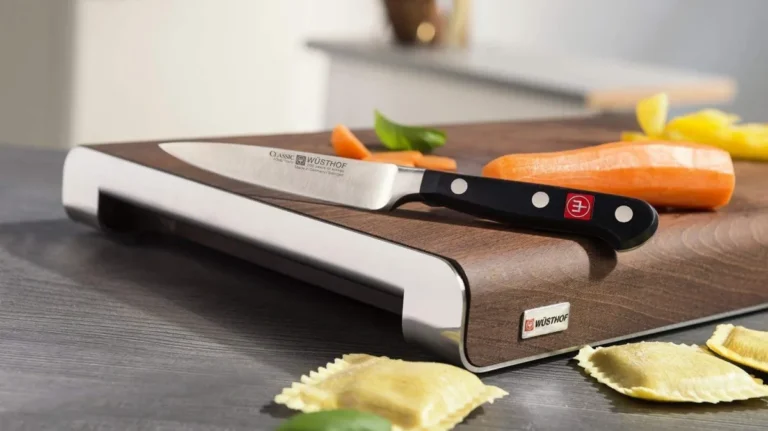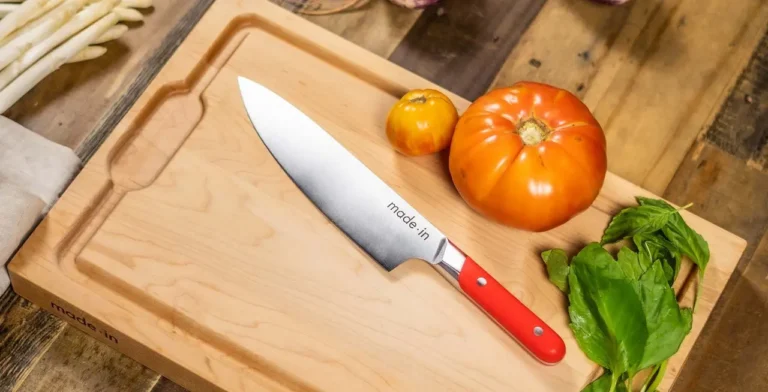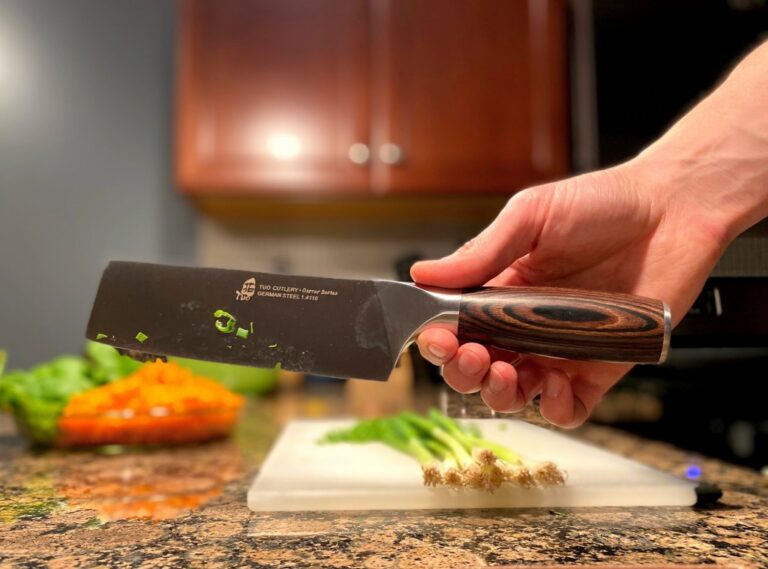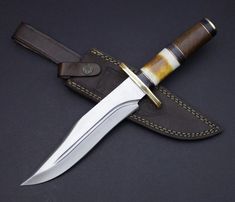How To Sharpen A Bread Knife
A sharp bread knife is a kitchen essential, and keeping it in good condition is vital. A well-maintained bread knife ensures clean and precise cuts, making your slicing tasks effortless. In this guide, we’ll show you how to sharpen your bread knife step by step, without getting tangled in complicated jargon or machinery.

Tools and Materials
Let’s get our tools and materials in order. You’ll need a few basic items:
- Your dull bread knife
- A whetstone or sharpening rod (or an electric knife sharpener)
- A damp cloth
- A bowl of water (if using a whetstone)
- A towel or non-slip mat to secure your workspace
- Safety gloves
- Safety goggles (for electric sharpeners)
Safety Precautions
Safety should be your top priority. Always remember to:
- Work in a well-lit and well-ventilated area.
- Keep the workspace clean and organized to avoid accidents.
- Use safety gloves and goggles to protect your hands and eyes from potential injuries.
- Keep the knife and sharpening tools out of the reach of children and pets.
Assessing Your Knife
It’s important to determine if your knife truly needs sharpening. Look for these signs:
- Jagged or uneven cuts.
- Increased effort is required to cut.
- The blade edge appears rounded or dull.
Identifying the Type of Blade
There are different types of bread knife blades, and knowing which type you have can help you choose the right sharpening method:
1. Serrated Blade
This type has small, scalloped edges and requires a specific approach.
2. Scalloped Blade
This blade has larger, rounded serrations.
3. Wavy Blade
This type features a combination of small and large scallops.

Choosing the Right Sharpening Method
You have a few options for sharpening your bread knife. Let’s consider which method suits you best:
Honing vs. Sharpening
Honing involves realigning the blade’s edge without removing much material. It’s a maintenance task to be performed regularly. Sharpening involves removing material from the blade to create a new edge.
Manual vs. Electric Sharpeners
Manual sharpening methods include using a whetstone or a sharpening rod. These require manual effort and precision. Electric sharpeners automate the process, making it more accessible for those less confident in their manual skills.
Whetstone vs. Sharpening Rod
If you decide to go the manual route, you’ll need to choose between a whetstone and a sharpening rod. A whetstone offers different grit levels for coarse and fine sharpening. A sharpening rod is a handy tool for maintaining a sharp edge.
Manual Sharpening with a Whetstone
Now, let’s get into the nitty-gritty of manually sharpening your bread knife with a whetstone. This method is labor-intensive. It allows for precise control over the sharpening process.
Setting Up Your Workspace
- Place a non-slip mat or a damp towel under the whetstone to prevent it from sliding.
- Ensure good lighting to see the blade.
Soaking the Whetstone
Whetstones require soaking in water before use. If your whetstone is one of them, follow the manufacturer’s instructions and soak it for the recommended time.
Correct Angle for Sharpening
Maintaining the right angle is crucial. Hold the knife at a 20 to 25-degree angle to the whetstone. You can check the angle using a simple angle guide if needed.
Step-by-Step Sharpening Process
- Start with the coarse side of the whetstone. Apply a few drops of water to keep it lubricated.
- Place the knife’s serrations against the stone and, with gentle pressure, move the knife in a sweeping motion along the length of the blade. Be consistent and work on both sides.
- Repeat this process.
- Switch to the finer side of the whetstone and repeat the sharpening process.
- Test the sharpness by slicing through a piece of bread or a tomato.
Using a Sharpening Rod
If you prefer a sharpening rod, follow these steps to restore your bread knife’s edge:
- Place a non-slip mat or damp towel on your work surface to prevent slipping.
- Ensure good lighting for a clear view of the blade.
Proper Technique for Sharpening with a Rod
- Hold the sharpening rod in one hand and the knife in the other.
- Position the rod vertically on the work surface.
- Hold the knife’s serrations against the rod at a 20 to 25-degree angle.
- Draw the knife down the rod in a gentle, sweeping motion.
- Repeat the process for each serration along the blade.
- Test the sharpness by slicing through a piece of bread or a tomato.
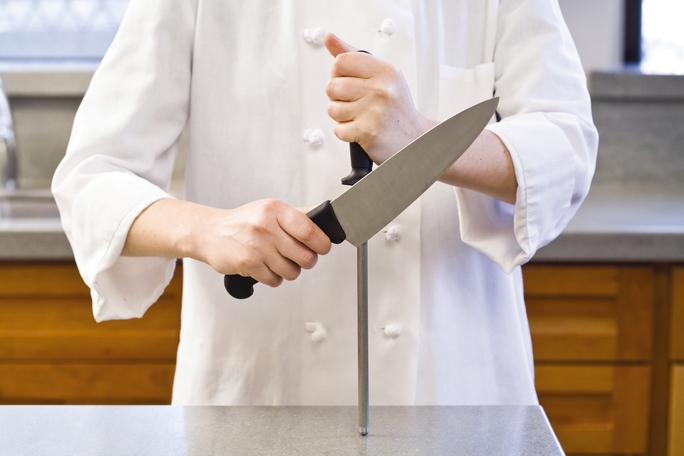
Electric Knife Sharpeners
Electric knife sharpeners are user-friendly and efficient. If you choose this method, here’s how to use it:
Benefits and Drawbacks
Electric sharpeners are quick and easy to use, making them a popular choice. It shortens the knife’s lifespan.
How to Use an Electric Sharpener
- Read the manufacturer’s instructions for your specific sharpener.
- Place the sharpener on a stable surface.
- Insert the knife blade into the appropriate slot.
- Turn on the sharpener and follow the recommended process.
- Test the sharpness by slicing through a piece of bread or a tomato.
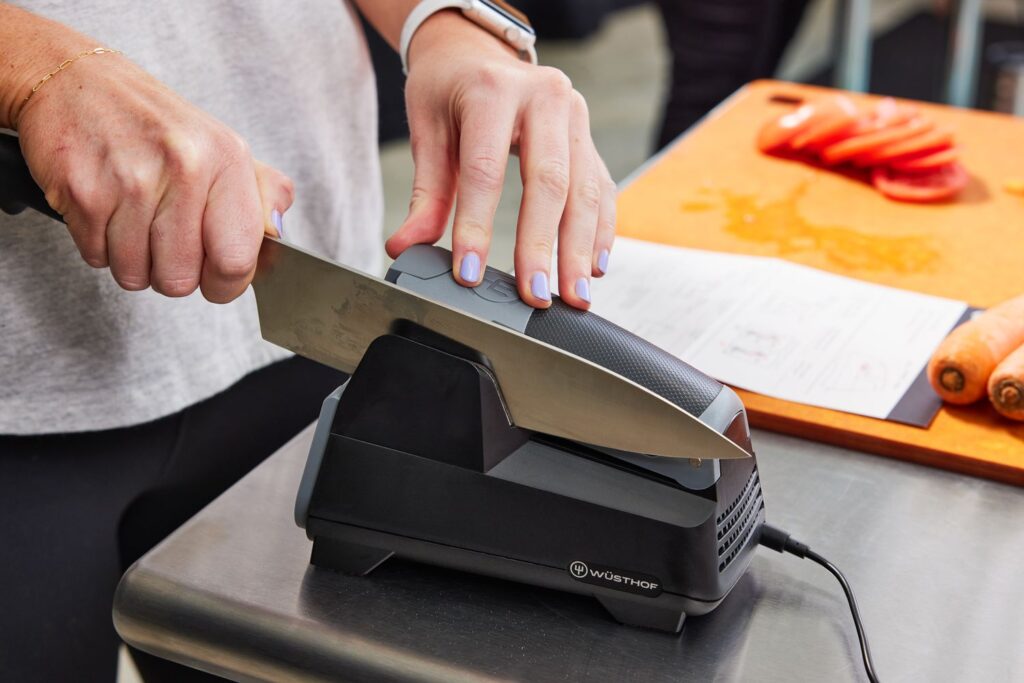
Safety Tips
Electric sharpeners are powerful; be cautious:
- Use safety goggles to protect your eyes from any metal shavings.
- Follow the manufacturer’s guidelines for safety and operation.
- Keep your fingers away from moving parts.
Honing Your Bread Knife
Honing is a maintenance step to ensure your knife’s edge remains aligned. Regular honing keeps the blade in top shape and prolongs the time between sharpening sessions.
How to Hone Your Knife
- Hold the honing rod vertically on a stable surface.
- Hold the knife at a 20 to 25-degree angle against the rod.
- Draw the knife down the rod in a gentle, sweeping motion.
- Repeat this process for each serration along the blade.
Maintaining a Sharp Edge
A freshly sharpened bread knife is a joy to use, and with some proper maintenance, you can keep it that way.
Proper Knife Storage
- Store your knife in a knife block or on a magnetic strip.
- Avoid storing knives in a drawer to prevent dulling or damage.
Regular Maintenance
- Check for any signs of dullness and hone it.
Final Words
A well-sharpened bread knife is a kitchen essential that transforms ordinary tasks into satisfying experiences. In this guide, we’ve simplified the sharpening process, making it accessible for all. Whether you choose manual methods like using a whetstone or sharpening rod, or opt for the convenience of an electric sharpener, you’re now equipped to revive your knife’s precision.

